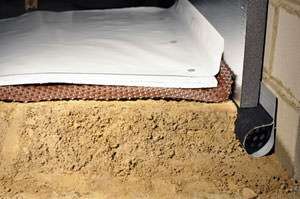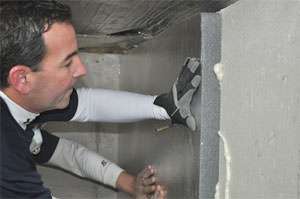Crawl Space Products in Quebec, Ontario

Proven solutions for damp, dirty crawl spaces
Conditions in a crawl space can have a very significant effect on the living space above this shallow foundation. If the crawl space is damp, dirty and moldy, odors and hazardous mold spores from this unpleasant environment can easily make their way into your living space. Left unchecked, a damp crawl space can ruin building materials and pose a serious threat to building safety and structural integrity. But these bad outcomes don't need to occur if you take action to create a dry, clean environment in your crawl space.
Developed by Basement Systems, the CleanSpace encapsulation system is designed to solve crawl space problems. Using an exclusive line of patented products, a CleanSpace crew can transform even a "worst-case" crawl space into a clean, dry foundation that's an asset to the house rather than a liability. Here are brief descriptions of the main products in the CleanSpace system.
Crawl Space Drainage Systems

It's critical to keep the crawl space dry if you want to avoid problems with mold, mildew and wood rot. A drainage and sump pump system is the best way to move water out of the crawl space –even water that seeps into the space at a steady rate. The SmartPipe perimeter drainage system installs against crawl space walls and is designed to capture water than runs down the wall as well as water that soaks through the soil. The perforated plastic pipe resists clogging because of the filter fabric that covers the pipe's drainage holes.
To promote drainage across the crawl space floor and seal out moisture, we recommend installing special CleanSpace Drainage Matting, and covering the plastic matting with our 20mil CleanSpace moisture barrier. The matting promotes water movement to the perimeter drains, while the moisture barrier ensures that the crawl space floor will remain dry.
The final ingredient in our crawl space drainage system is our SmartSump sump pump. At the low point in the crawl space, we create a depression where the sump pump can be installed. The pump itself is housed in a durable plastic sump liner with an airtight protective cover. SmartPipe drainage lines are connected to the sump liner to deliver water to this collection point. When the water reaches a preset level in the liner, the pump comes on automatically, pumping water outside the house. An optional backup battery is available, to keep the drainage system operational during a power outage.
Crawl Space Dehumidifiers

Installing a CleanSpace drainage system will get rid of standing water in the crawl space. But some crawl spaces require an extra measure of protection against moisture damage in the form of a dehumidifier. Designed to remove moisture from the air, a dehumidifier can keep crawl space humidity below 60%, creating a dry environment that's hostile to mold, mildew and wood rot.
The SaniDry CX Dehumidifier is designed specifically for use in the most challenging crawl space environments. It will drain automatically into a crawl space sump pump, and turn off automatically when a preset humidity level is attained.
Crawl Space Insulation

Insulation is just as important in the crawl space as it is in other parts of the house; it increases interior comfort while decreasing heating and cooling costs. Many vented crawl spaces are insulated by installing fiberglass batts between joists in the crawl space. Today, building scientists recommend sealing or "encapsulating" the crawl space (instead of venting it), and using rigid foam insulation instead of fiberglass batts. Unlike fiberglass insulation, rigid foam won't compress, lose R-value, fall out of place, support mold growth or be damaged by moisture. The crawl space encapsulation strategy calls for rigid foam insulation to be installed against crawl space walls.
Crawl Space Liner
To encapsulate a crawl space, it's necessary to install a moisture barrier that's continuous from the top of the wall, down to the floor, and all across the floor as well. We accomplish this huge sealing task with the CleanSpace liner, a super-durable, 20-mil plastic membrane that's reinforced with polyester cord. Seams between adjacent sheets of CleanSpace liner are sealed with special poly tape.
If the crawl space was built with hollow-core concrete block, we install a clear plastic WallCap across the top of the wall. WallCap covers the open block cores, helping to stop air leakage while also discouraging insects and other pests from entering the crawl space or nesting in the block cores. The CleanSpace treatment truly transforms a dirty, damp crawl space into an under-house storage area you don't mind visiting.
Crawl Space Vent Cover & Doors
Converting an older vented crawl space into an encapsulated CleanSpace calls for sealing vents, doors and other connections to the outside. Because wood doors and vent covers can crack, warp and deteriorate over time, we use strong plastic vent covers and crawl space doors.
Our CleanSpace Vent Covers are designed to fit standard crawl space vent openings. We provide oversized EverLast Crawl Space Doors that can be cut to fit different size door openings. Still another possibility is the Turtl crawl space entry well system. This entry well includes a cover and a crawl space access door. All crawl space vent covers and doors include durable gaskets that prevent outside air from leaking into the crawl space.
Crawl Space Support Posts
Most crawl spaces are designed with a central beam that provides mid-span support for floor joists. If the posts that support this beam settle or shift, the beam can sag. This in turn causes the floor above to tilt, sag or become excessively springy.
To strengthen floor framing above a crawl space and return sagging floors to level, we install the SmartJack supplemental support system. Unlike a wood support post that can decay or crack, the SmartJack support is made from galvanized steel, with a heavy-duty threaded strut that can be adjusted to elevate a settled beam.

